Native American Church of Idaho celebrates 100th anniversary

NAC of Idaho 100th Anniversary event attendees at the Sho-Ban Casino Hotel event center.
By LORI ANN EDMO
Sho-Ban News
FORT HALL — The Native American Church (NAC) of Idaho celebrated 100 years of existence as the charter was signed April 1, 1925, in an event at the Shoshone-Bannock Casino Hotel June 13 and 14.
The signers of the NAC of Idaho Charter were acknowledged and their families recognized. They include: Jack Attedmo (Edmo), Eugene Diggie, Peter Jim, and Grant Martin.
Prayer meetings were at the Shoshone-Bannock Festival grounds June 14, along with the Saturday dinner the descendants of Grant Martin and Peter Jim hosted. The families of Eugene Diggie and Jack Attedmo (Edmo) cooked the June 15 lunch.
At the Saturday presentations, NAC Board President Franklin Devinney said, “Long ago, the elders, they brought this medicine back over here to what's our reservation here. And ever since back then, they laid down the sacred tobacco. They offered prayer, for our people here.” He said they’ve been carrying that on, carrying them prayers, abiding by the teaching that was laid down, “the foundation that was laid down for us. And we're still holding on to that. We're still holding on to the Charter. We're taking care of it the best way we know how, the best way we can.” He thanked everyone who came to join in the celebration to honor our medicine, our ways and have good fellowship.

Native American Church (NAC) of Idaho 100th Anniversary T-Shirts presented
to attendees.
Lemuel Stone, NAC board member and custodian, introduced other board members Anthony Pete Broncho, vice president, Wanda Devinney, treasurer, Shanna Devinney, secretary, Sarah Tendoy, board member, along with Sandy Navo, board member. Regarding the prayer meetings that night, Jake Whiteplume from Nez Perce, Murray Sope from Shoshone-Paiute, Devinney, NAC president, Curtis Sam, Paiute Shoshone, along with Stone was conducting them. Each of the board members were sitting in one of the meetings. He said they’re honored and blessed those attending took time out to attend because it takes a lot of resources to travel.
Comanches receiving the sacrament
Edmond Nevaquaya, Comanche, explained the history of NAC and their 1918 Charter. Growing up he’s talked with a lot of older people to hear their songs and stories. He teaches his children and grandchildren. The 1918 Charter has regulations, policies, things people have to abide by in order to be a registered church. Before it became a church, he said it was a ceremony, it wasn’t created by mankind – it was given by the medicine. Before the coming of the white man, the ceremonies were called that it was a people they referred to as Yulta stuck amongst English names such as Apache, Comanche Kiowa. And at that time, they heard a lot of people were colonized and in colonization they were told to forget their ways, language, spirituality, have to go to schools. In residential schools all that began. Before that time there was a get together of a tribe called lapan Apaches. From what they know today they recognize Comanches. They call them Mescalero Apaches. There was a woman running from an enemy, she came through an area that was a peyote garden – rough terrain, cactus, thorns or stickers, snakes, spiders – everything that crawls and moves. While she was moving, she was afflicted by all those things – getting cut by the thorns, running for her life, trying to get out of there, she laid down, then heard a voice and it told her to raise up, lift up, pick me up and put me in your mouth. She bit the peyote, she become part of the spirituality. The medicine started instructing her to take the saliva and juice of the peyote noting saliva is a powerful thing. The voice told her if she ingests it, she will get well. She was told a little fox was going to lead her out, then an eagle and horse that took her back to her people. She took the peyote back to her Comanche people. They were trying to develop a ceremony, the peyote told them there were folks coming. Their people encountered four warriors – one, his name was sound of the morning sun, they came up on this hill and down in the valley there was a brush arbor – there was some people in there making noise. One of the warriors said he was going to ride down there to find out what they were doing, his partner told him he better not – those are their enemies, they’re gonna kill you but he said if it’s his day to die, he’s just going to go on. When the warrior opened the door at the brush arbor it was Apaches sitting around – one of them spoke in Comanche, he come here, gave the medicine and that’s how it started for their people. They took it back to their people, began to make protocol. They have starting songs, midnight water songs, morning songs. They have songs for night, daytime and even the water. It was told by the peyote.
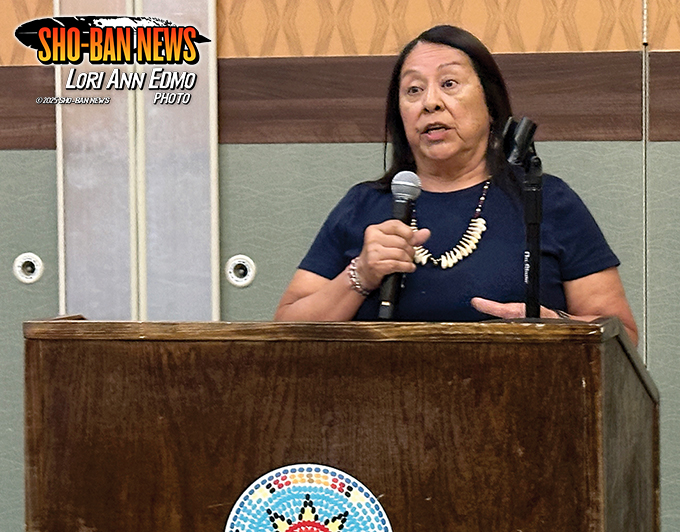
Sho-Ban attorney Jeanette Wolfley presented a review of American Indian Religious
Freedom Act amendments.
Nevaquaya said the U.S. government began to dictate how things should be moving tribal people from their homelands to different reservations. The original Comanche reservation was in a place called Fort Hood, Texas but when they were put on reservation there wasn’t enough food so they’d go out hunting. When they went off the reservation the government started hunting them down or kill them. They had a chief his name was Pewo. The government sold their land and moved them to Oklahoma. When they were moved, they were waiting on payment for the land sold, Pewo was fighting for what was owed. He testified before Congress about the atrocities his people faced including being punished for their ceremonies. A Congressman listened advising in the Constitution there is freedom of religion, freedom of worship advising to charter the ceremony, charter the church. So they made rules and regulations – it’s called the 1918 Charter. He said the people’s names on the Charter did all the work but it was because of one chief that went out for his people so the church could be free and worship. The grandfathers told the Comanches it was written and don’t mess with it or bother it. “And those laws have never been broken today,” Nevaquaya said. He said the biggest concern is the medicine getting used the pharmaceutical way. It comes down to prayer. His grandpa told him if he’s ever going to run a meeting, you better believe in what you say. “So my prayer if for that medicine to be free, for that medicine to always be around. I have to believe it and trust in it.” He talked about historic trauma when children were taken for their people to place in boarding schools getting punished for speaking their language. Also those who joined the Armed Services who returned with Post Traumatic Stress disorder. There was alcoholism, spousal abuse but there no intervention back then. Their mindset was changed. Part of the 1918 mission statement when people came to a meeting, ate the herb, their lives began to change. They began to treat each other better. Nevaquaya said their Chairman Tahdooahnippah is a participant and he prays with them. An old man said if you’re going to be a chief, you have to stand up for your people. Nevaquaya works in prevention recovery, has seen many people in addiction, he’s told them about NAC and how they’ve become productive people. “It’s wonderful what medicine does,” he said.
Shoshone-Bannock tribal elder Fred Auck acknowledged the men who went to Oklahoma and brought the medicine back – it’s because of them we’re allowed to worship. He said the church is an old one it dates back 2,000 years. Under the NAC have to talk to the almighty he was taught as a little boy, “It’s a gift, kind of like a bible to us. I’m glad it’s been taken care of for 100 years. He recalled there was meetings across from the boarding school where Jack Edmo had meetings. He also remembered there were tipis in the hills. He also said the sacrament has ability to talk if one is worthy. He also talked about other memories he has of NAC.
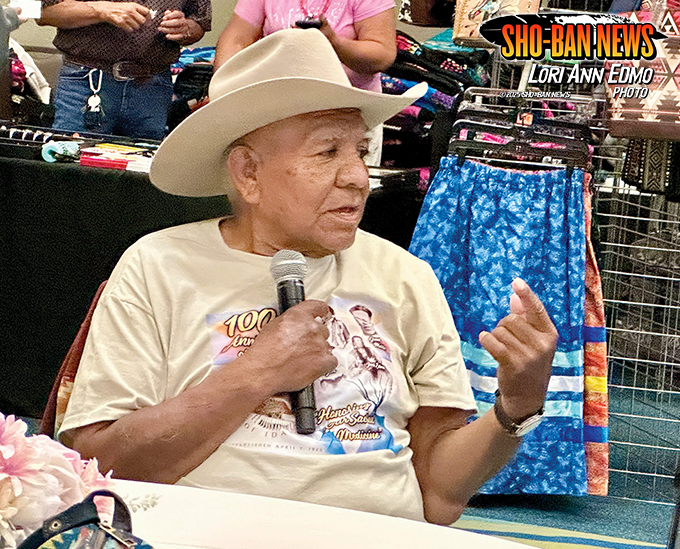
Tribal elder Fred Auck speaks at the event.
After lunch, an open microphone was available for attendees to talk. Archie Arkinson, Cree, said his late father Tom Arkinson went to boarding school in Fort Hall in the 1930s and learned how to talk Shoshone. He had a lot of friends here and used to go to NAC ceremonies here with the old folks. He appreciated Edmond Nevaquaya sharing the history of the 1918 Charter. “You know they’re the first ones that used the peyote and they introduced this medicine to us.” He’s glad for the Shoshone-Bannock’s 100-year anniversary – for the way the board of directors wanted to celebrate, honor and commemorate the old people – the men listed. He was told the Crees and Shoshones were good friends not enemies.
Adeline Matsaw, Shoshone-Bannock, shared her memories, reflecting how things used to be.
Louise Dixey introduced Jack Edmo descendants present, along with Eugene Diggie’s. She acknowledged family members from Peter Jim.
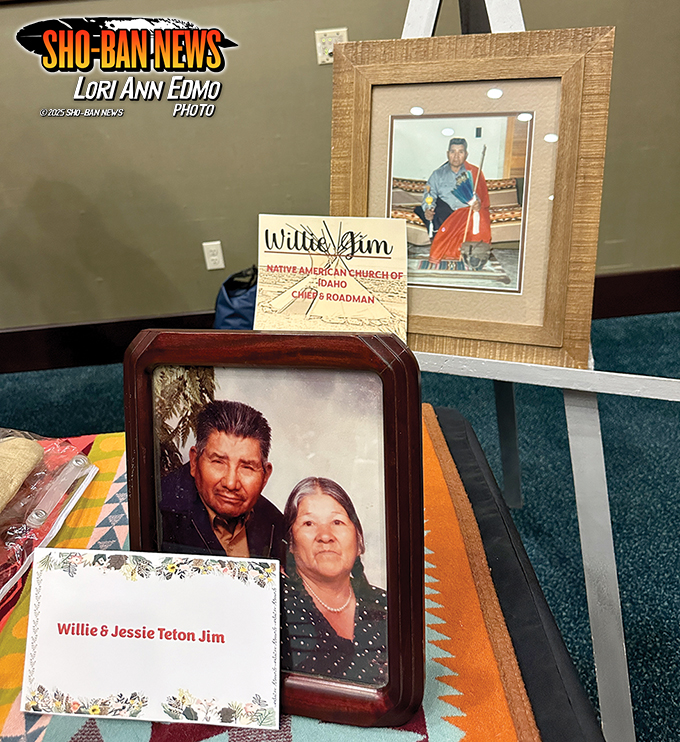
Willie & Jessie Teton Jim family table display at the event.
Audrey Jim, Iola Hernandez and Cheryl Bagley were present from Peter Jim’s family. Audrey said her parents are Willie Jim and Jessie Teton Jim. Willie was a NAC Chief. They recall him prepping for meetings and how he would pray for them all the time. He did a lot of traveling, people would ask him to lead prayers. She said they would stay home with their mom. He was very good teacher. Iola said their dad talked to them when they were kids. He showed them what to do with the medicine.
Louise explained the Diggie side of the family. Great uncle Eugene Diggie was one of the founders. She introduced Velda Racehorse who talked about Eugene saying he was married three times and had many children. After the men brought the medicine back from Oklahoma they’d have ceremonies in the hills, had to hide. Long time ago they used to break up Sundance ceremonies. Eventually they found out about Comanche what they were doing, brought the teachings back here. Eugene was also part of the 101 Ranch – Buffalo Bill show. There’s photos of him going to the peyote gardens. In 1975, the church members voted to make the Charter perpetual. She recalled her uncle was quite a character. He was the only son born to her grandparents. He had six sisters.
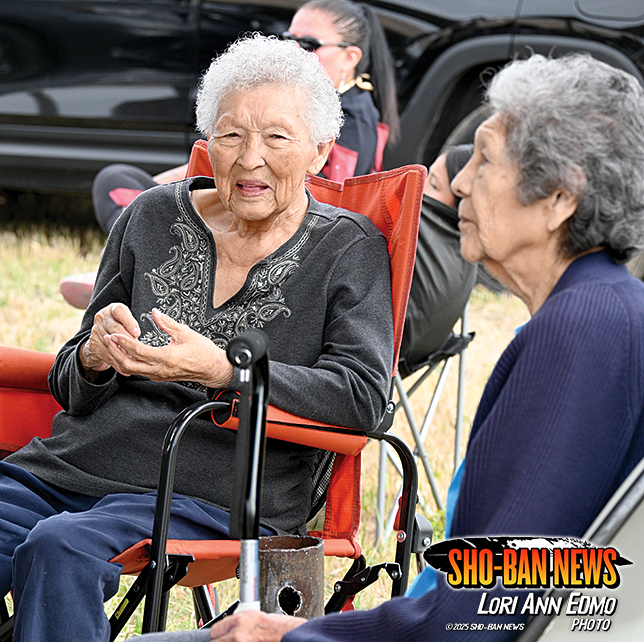
Broncho ladies enjoy the feast on Saturday, June 14.
Jeanette Wolfley, retired Shoshone-Bannock tribal attorney, did a review of American Indian Religious Freedom Act amendments, along with current issues/challenges to the sacrament. She said Congress approved the American Indian Religious Freedom Act (AIRFA) in 1978 to remove barriers to Native people for the practice of ceremonies. Initially, NAC sought to include peyote protections but were unable to gain support. Instead, NAC is included under the traditional leaders and ceremonies class in the AIRFA report. Inherent Right for Native way of life and to right to practice our ceremonies, to pray, to sing and protect our sacred sites.
• In 1990, in Oregon v. Smith, the Supreme Court decided that peyote was not protected under the 1st amendment or AIRFA. The Court held that the denial of unemployment benefits to a member of the Native American Church for using the peyote in the practice of his religion was not a violation of the free exercise clause of the First Amendment. It was a major blow to the AIRFA and NAC.
• NAC of Idaho Board immediately were concerned about the protection of the use, possession and transportation of peyote. They decided to pursue a new law that would protect such use in Idaho and proposed legislation to the Idaho legislation. Two busloads of NAC members travelled to Boise to testify and support the bill. It was a successful victory when the State passed legislation in 1991 to protect the use, possession and transportation of peyote that is used by federally recognized tribal members in a bona fide ceremony. The law established that the state would not prohibit or prosecute NAC members in Idaho.
• On the federal level, given the Smith decision, the NAC sought an amendment to the AIRFA, to include protections for Peyote, eagle feathers, sacred sites and prisoners’ rights. There were ongoing negotiations and many drafts of legislation. Finally, in 1994 the Amendment to AIRFA was completed. Like the Idaho law, the Amendment established the federal government could not prohibit or prosecute (A) members of a federal recognized tribes to ingest, transport or possess peyote, and (B) only for a bona fide ceremony.
• There are two major issues facing NAC today. First, preservation of the peyote in its natural habitat. The land where it grows is shrinking. Second, enforcement of the laws against non-Indian abuse of our medicine.
—The 1994 Amendment does not address the medicine’s survival. Peyote only grows in 4 counties in Texas. It is not growing on state or federal lands, But on private lands. Private landowners have no interest in preserving the medicine. Instead, they are developing the lands for cultivation or wind farms. The land base is shrinking where peyote is growing. Conservation and preservation of peyote is a necessity. NAC is proposing the federal government to initiate project to protect the peyote, preserve the land base, and to develop regulations to preserve the lands. Funding is necessary to address this issue.
There is no effort to Amend the AIRFA, the language is fine. Need to ensure land base survives.
—Enforcement is important. AIRFA states peyote is used by members of federally recognized tribe in a bona fide ceremonial manner. This language is clear. Non-Indians are trying to use peyote for psychedelic, pharmaceutical purposed, by extracting the mescaline out the peyote. This would be commercialized by big pharma companies. The federal government must take enforcement actions to prosecute for violation of the drug laws. NAC are the only ones who are exempt.
—Non-Indians are also seeking to decriminalize state laws that prohibit the use of peyote and mescaline. Such change would impact the NAC use, and growing demand for peyote in Texas.
NAC of Idaho passed a Resolution against decriminalization and sent it to our Congressional delegation.
Efforts to educate Congress on the distinction between religion and ceremony. It is a matter that is no longer just peyote ceremonies, all forms of medicines, cultural protocols which are embedded in prayers. These are ceremonies that are present in our everyday life.
Wolfley said before AIRFA, NAC members had to fight for religious freedom. “This inherent right to practice our religion was not a given. We have moved past that era. The next generation must continue the work to protect and expand control of the land where the peyote is grown. This means that we need to collaborate with other tribes, we need to build awareness in our youth, be inclusive of others who can help out.”
The NAC Board conducted a giveaway for visitors and T shirts were given.
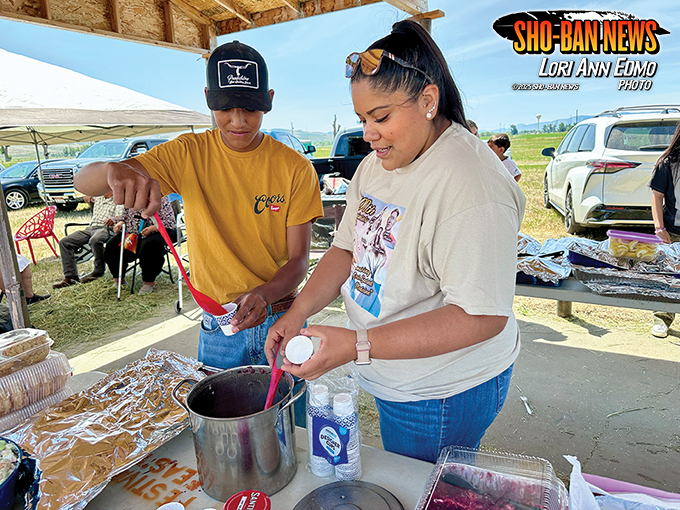
Gator Boyd and Kaycee Dixey serve chokecherry pudding on Sunday, June 15.





